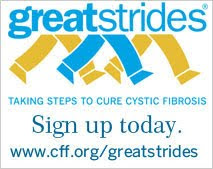1938 Dorothy Andersen, M.D. writes the first comprehensive medical report on cystic fibrosis (CF).
1953 During a heat wave in New York City, Dr. Paul di Sant’Agnese and others connect the extra loss of salt by people with CF to the disease's underlying problem.
1955 The Cystic Fibrosis Foundation becomes incorporated as the National CF Research Foundation and awards the first research grants to Drs. di Sant’Agnese, Andersen and Shwachman.
1961 The Cystic Fibrosis Foundation-accredited care center program begins with two centers being established.
1962 The CF predicted median survival age is 10 years.
1962 A total of 30 Cystic Fibrosis Foundation-accredited care centers are now in operation.
1964 To investigate CF at the cellular level and find answers about this complex disease, the Cystic Fibrosis Foundation establishes the first basic science committee.
1966 The Cystic Fibrosis Foundation launches a patient data registry that includes the history of patients seen at CF Foundation-accredited care centers.
1978 The number of Cystic Fibrosis Foundation-accredited care centers totals more than 100.
1980 The Cystic Fibrosis Foundation creates the Research Development Program, a network of research centers at leading universities and medical schools nationwide.
1988 The Cystic Fibrosis Foundation launches the Cystic Fibrosis Services Pharmacy.
1989 A team of Cystic Fibrosis Foundation-supportes scientists discovers the defective CF gene and its protein product (CFTR) thus opening the door to understanding the disease at its most basic level.
1990 CF researchers achieve “proof of concept” that gene therapy (in the lab dish) is possible.
1993 Landmark gene therapy trial begins in people with CF.
1994 The Food and Drug Administration (FDA) approves Pulmozyme, which is proven to thin the tenacious, sticky mucus in the lungs - and is the first drug developed specifically for CF. The time taken to develop Pulmozyme is less than half of the industry average.
1997 The Cystic Fibrosis Foundation establishes the Therapeutics Development Program.
1997 The FDA approves TOBI, the first aerosolized antibiotic designed for CF, which is proven to reduce hospital stays and improve lung function.
1998 Specialized clinical research centers are designated as the Cystic Fibrosis Foundation’s Therapeutics Development Network.
2000 Cystic Fibrosis Foundation Therapeutics, nonprofit research affiliate of the CF Foundation was established to govern drug discovery and development efforts.
2000 Scientists supported by the Cystic Fibrosis Foundation map the entire genetic structure of the most common cause of CF lung infections-the Pseudomonas aeruginosa bacterium. Researchers can identify the function of specific genes and find ways (drugs) to turn off the bad ones.
2002 A Cystic Fibrosis Foundation Therapeutics-supported study shows azithromycin improves CF lung health.
2003 Cystic Fibrosis Foundation Therapeutics-supported scientists at Structural GenomiX, Inc. determine the 3-dimensional structure of a portion of the CFTR protein, opening the door to more drug discovery opportunities.
2004 Cystic Fibrosis Foundation Therapeutics-supported studies in Australia and at the University of North Carolina show that hypertonic saline helps clear CF mucus. It is proven to improve lung function and reduce hospital stays, and becomes a therapeutic option.
2006 The predicted median age of survival for those with CF increases to 37 years.
2006 VX-770, a drug in development by Vertex Pharmaceuticals with support from the Cystic Fibrosis Foundation, enters clinical trials. VX-770 is one of the first compounds to attack the root cause of CF, and works at the cellular level to open chloride channels that do not function correctly in people with the disease.
2007 Vertex Pharmaceuticals selects a second potential drug known as VX-809 for development. Like VX-770, VX-809 addresses the root cause of CF, but it works by helping the defective CF protein move to its proper place in the cell.
2007 Gilead Sciences, Inc. applies for FDA approval for its inhaled antibiotic therapy, aztreonam lysine, which has been shown to improve respiratory symptoms in CF patients.
2008 The Foundation and Vertex Pharmaceuticals achieve a “proof of concept,” showing that it is possible to treat the root cause of CF. During Phase 2 studies of VX-770, trial participants, all of whom carry the G551D mutation of CF, show unprecedented improvements in key signs of the disease.
2008 More than 30 potential therapies are in the Foundation’s drug discovery and development pipeline. The more drugs in the pipeline, the greater the odds of producing successful therapies and a cure for CF.
Thursday, October 1, 2009
Research Milestones
Posted by Robin at 10:45 AM 0 comments
Labels: "Cystic Fibrosis", Cure, Cystic Fibrosis Foundation, Milestones
Subscribe to:
Posts (Atom)









